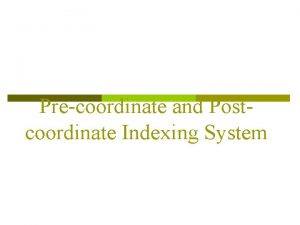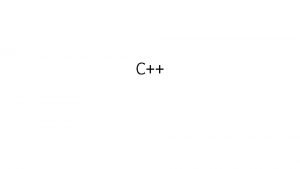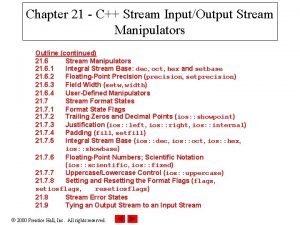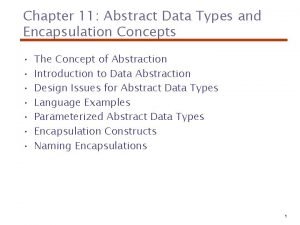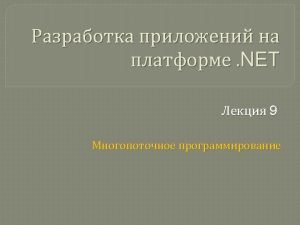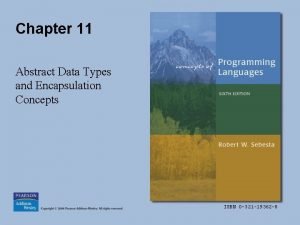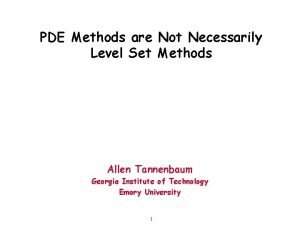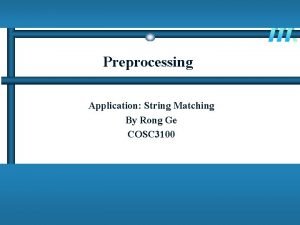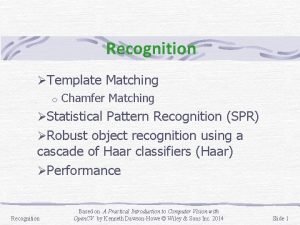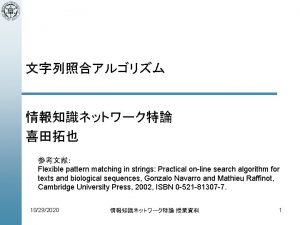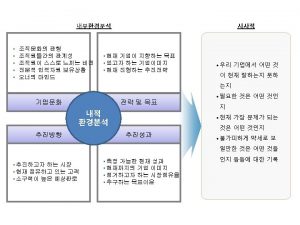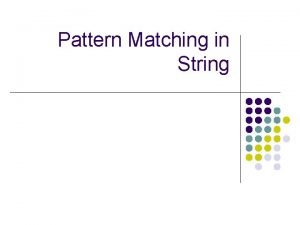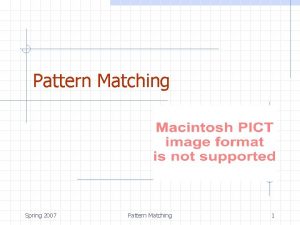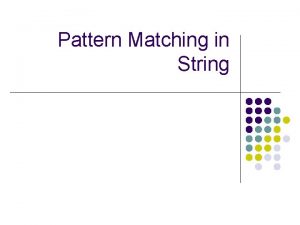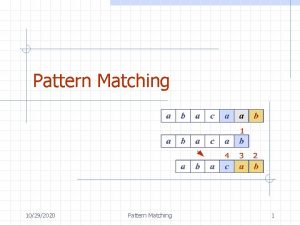PARAMETERIZED TEXT INDEXING Rahul Shah Pattern Matching Input






![p-BWT and LF mapping • Parameterized Suffix Array: • p. SA[i] = j and p-BWT and LF mapping • Parameterized Suffix Array: • p. SA[i] = j and](https://slidetodoc.com/presentation_image_h2/7496f6554bd01e0b27abed21d12ccb3e/image-7.jpg)
![Data Structures • WT over p. BWT • Operations: • p. BWT[i] • range. Data Structures • WT over p. BWT • Operations: • p. BWT[i] • range.](https://slidetodoc.com/presentation_image_h2/7496f6554bd01e0b27abed21d12ccb3e/image-8.jpg)
![Compute LF(i) when L[i] is static • Both L[i] and L[j] are static • Compute LF(i) when L[i] is static • Both L[i] and L[j] are static •](https://slidetodoc.com/presentation_image_h2/7496f6554bd01e0b27abed21d12ccb3e/image-9.jpg)
![Compute LF(i) when L[i] is parameterized • z = locus of the string prev(Ti)[1, Compute LF(i) when L[i] is parameterized • z = locus of the string prev(Ti)[1,](https://slidetodoc.com/presentation_image_h2/7496f6554bd01e0b27abed21d12ccb3e/image-10.jpg)
![Compute LF(i) when L[i] is parameterized • LF(i) = N 1+N 2+N 3+N 4, Compute LF(i) when L[i] is parameterized • LF(i) = N 1+N 2+N 3+N 4,](https://slidetodoc.com/presentation_image_h2/7496f6554bd01e0b27abed21d12ccb3e/image-11.jpg)
![Compute LF(i) when L[i] is parameterized • N 2 = number of j’s, such Compute LF(i) when L[i] is parameterized • N 2 = number of j’s, such](https://slidetodoc.com/presentation_image_h2/7496f6554bd01e0b27abed21d12ccb3e/image-12.jpg)
![Compute LF(i) when L[i] is parameterized • N 3 = 0 • N 4 Compute LF(i) when L[i] is parameterized • N 3 = 0 • N 4](https://slidetodoc.com/presentation_image_h2/7496f6554bd01e0b27abed21d12ccb3e/image-13.jpg)





- Slides: 18

PARAMETERIZED TEXT INDEXING Rahul Shah

Pattern Matching • Input: a text T and a pattern P • Output: all positions in T where P appears as a substring. • Indexing Problem: • T is fixed • P is provided as a query • Data Structures for Indexing Problem: • Linear Space (in words): Suffix Tree, Suffix Array • Succinct/Compact Index: FM-Index, Compressed Suffix Array

Parameterized Pattern Matching • Alphabet Σ consists of two disjoint sets: • Static characters Σs • Parameterized characters Σp • Parameterized string (p-string) is a string in (Σs U Σp)* • Two p-strings S = s 1 s 2…sm and S’ = s’ 1 s’ 2…s’m match iff • si = s’i for any si in Σs • There exists a bijection ƒS that renames si to s’i for any si in Σp • Example: Σs = {A, B} and Σp = {w, x, y, z} • Ax. By and Aw. Bz p-match • Ax. By and Aw. Bw do not p-match

Baker’s Encoding • Convert a p-string S into a string prev(S) where • |prev(S)| = |S| • prev(S)[i] = S[i] if S[i] is static • prev(S)[i] = 0 if i is the first occurrence of the p-character S[i] • prev(S)[i] = (i – j) if j<i is the rightmost occurrence of the p-character S[i] • Example: • S = Ax. By. Bz. Ax. Bz • prev(S) = A 0 B 0 B 0 A 6 B 4

Baker’s p-Suffix Tree • Two p-strings S and S’ p-match iff prev(S) = prev(S’) • p-Suffix Tree: • Encode every suffix according to prev(. ) • Construct a suffix tree for every encoded suffix • Construction time: • Baker: O(n|Σp| + n log |Σ|) • Kosaraju: O(n log |Σ|) • Searching in p-Suffix Tree • Encode P using prev(. ) • Search in p-Suffix Tree for prev(P) • Time: O(|P| log |Σ| + occ)

Parameterized BWT • Take every circular suffix Ti and sort according to prev(. ) • Obtain the last characters L[i] in sorted order • fi = first occurrence of L[i] in Ti • Define p. BWT[i] as follows: • = L[i], if L[i] is static • = number of 0’s in prev(Ti)[1, fi], otherwise
![pBWT and LF mapping Parameterized Suffix Array p SAi j and p-BWT and LF mapping • Parameterized Suffix Array: • p. SA[i] = j and](https://slidetodoc.com/presentation_image_h2/7496f6554bd01e0b27abed21d12ccb3e/image-7.jpg)
p-BWT and LF mapping • Parameterized Suffix Array: • p. SA[i] = j and p. SA-1 [j] = i iff prev(Ti) is the jth lexicographically smallest suffix among all prev(Tk), 1 ≤ k ≤ n • LF Mapping: LF(i) = p. SA-1[p. SA[i]-1] i Ti prev(Ti) Sorted Ti p. SA[i] p. SA-1[i] L[i] 1 Ax. Byxx$ A 0 B 034$ yxx$Ax. B 4 5 B 2 x. Byxx$A 0 B 034$A xx$Ax. By 5 3 y 3 Byxx$Ax B 0 A 0$A 3 x. Byxx$A 2 6 A 4 yxx$Ax. B 001$A 3 B x$Ax. Byx 6 1 x 5 xx$Ax. By 01$A 3 B 0 Ax. Byxx$ 1 2 $ 6 x$Ax. Byx 0$A 3 B 06 Byxx$Ax 3 4 x 7 $Ax. Byxx $A 0 B 034 $Ax. Byxx 7 7 x f p. BWT[i] LF(i) = p. SA-1[p. SA[i]-1] B 6 2 1 A 5 1 2 $ 7 1 2 3 3 1 4 3 2
![Data Structures WT over p BWT Operations p BWTi range Data Structures • WT over p. BWT • Operations: • p. BWT[i] • range.](https://slidetodoc.com/presentation_image_h2/7496f6554bd01e0b27abed21d12ccb3e/image-8.jpg)
Data Structures • WT over p. BWT • Operations: • p. BWT[i] • range. Count(i, j, x, y) = number of k in [i, j] satisfying x ≤ p. BWT[k] ≤ y • Space: n log |Σ| bits • Time: O(log |Σ|) • Succinct representation of p-Suffix Tree • Operations on a node: • left. Most. Leaf, right. Mostleaf, qth child • parent, lca • Space: 4 n + o(n) bits • Time: O(1) • Additional O(n) + o(n log |Σ|) bits structure • Total Space: n log |Σ| + O(n) + o(n log |Σ|) bits
![Compute LFi when Li is static Both Li and Lj are static Compute LF(i) when L[i] is static • Both L[i] and L[j] are static •](https://slidetodoc.com/presentation_image_h2/7496f6554bd01e0b27abed21d12ccb3e/image-9.jpg)
Compute LF(i) when L[i] is static • Both L[i] and L[j] are static • LF(i) < LF(j) iff p. BWT[i] < p. BWT[j] or p. BWT[i] = p. BWT[j] and i < j • L[i] is static and L[j] is parameterized • LF(j) < LF(i) • If L[i] is static then determining LF(i) is easy using standard wavelet tree operations • = range. Count(1, n, 1, c-1) + range. Count(1, i, c, c), where c = p. BWT[i] • Time: O(log |Σ|)
![Compute LFi when Li is parameterized z locus of the string prevTi1 Compute LF(i) when L[i] is parameterized • z = locus of the string prev(Ti)[1,](https://slidetodoc.com/presentation_image_h2/7496f6554bd01e0b27abed21d12ccb3e/image-10.jpg)
Compute LF(i) when L[i] is parameterized • z = locus of the string prev(Ti)[1, fi] • Computed in O(log |Σ|) time using • WT and an additional O(n log |Σ|)-bit structure • v = parent(z), w = parent(v) • u = qth child of v • Computed in O(1) time using tree topology and additional O(n) bits
![Compute LFi when Li is parameterized LFi N 1N 2N 3N 4 Compute LF(i) when L[i] is parameterized • LF(i) = N 1+N 2+N 3+N 4,](https://slidetodoc.com/presentation_image_h2/7496f6554bd01e0b27abed21d12ccb3e/image-11.jpg)
Compute LF(i) when L[i] is parameterized • LF(i) = N 1+N 2+N 3+N 4, where Ni is the number of suffixes j in Si such that LF(j) ≤ LF(i) • N 1 = number of j’s, such that • L[j] is p-character, and fj > 1+|path(lca(z, leafj))| • Given by f. Sum(z) • f. Sum(. ) for all nodes can be maintained in O(n) bits and O(1) access time.
![Compute LFi when Li is parameterized N 2 number of js such Compute LF(i) when L[i] is parameterized • N 2 = number of j’s, such](https://slidetodoc.com/presentation_image_h2/7496f6554bd01e0b27abed21d12ccb3e/image-12.jpg)
Compute LF(i) when L[i] is parameterized • N 2 = number of j’s, such that • L[j] is p-character, and • fj > fi or fj = fi and j ≤ i • = range. Count(Lz, Rz, c+1, |Σp|) + range. Count(Lz, i, c, c), where c = p. BWT[i] • Computed using WT in O(log |Σ|) time
![Compute LFi when Li is parameterized N 3 0 N 4 Compute LF(i) when L[i] is parameterized • N 3 = 0 • N 4](https://slidetodoc.com/presentation_image_h2/7496f6554bd01e0b27abed21d12ccb3e/image-13.jpg)
Compute LF(i) when L[i] is parameterized • N 3 = 0 • N 4 = number of j’s, such that • L[j] is p-character, fj > fi, and • leading character on the path from v to leafj is parameterized • = range. Count(Rz+1, Ru, c+1, |Σp|), where c = p. BWT[i] • Computed using WT in O(log |Σ|) time

Summarizing LF(i) • Computed in O(log |Σ|) • Space is n log |Σ| + O(n) + o(n log |Σ|) bits • p. SA[. ] and p. SA-1[. ] can be computed in • Time: O(log 1+ε n) time • Space: additional O(n) bits • Sampled suffix array and inverse suffix array

Backward Search • Suffix range of P as follows • Given suffix range [sp, ep] of Q = proper suffix of P • c = preceding character of Q in P • Compute suffix range [sp’, ep’] of c. Q • Preprocess P in O(|P|log |Σ|) time such that for any p-character P[i], we can find • number of distinct p-characters in P[i+1, |P|] • number of distinct p-characters in P[i+1, ci], where ci is the first occurrence of c in P[i+1, |P|] • c is static • sp’ = 1+range. Count(1, n, 1, c-1) range. Count(1, sp-1, c, c) • ep’ = range. Count(1, n, 1, c-1) + range. Count(1, ep, c, c) • Time: O(log |Σ|)

Backward Search • c is parameterized and does not appear in Q • d = number of distinct p-characters in Q • (ep’-sp’+1) = range. Count(sp, ep, d+1, |Σp|) • Computed in O(log |Σ|) time • sp’ = 1 + f. Sum(1+f. Sum(lca(leafsp, leafep))) • Computed in O(1) time • c is parameterized and appears in Q • d = number of distinct p-characters in Q until the first occurrence of c • (ep’-sp’+1) = range. Count(sp, ep, d, d) • Computed in O(log |Σ|) time • sp’ = LF(imin), where imin= min{i | sp ≤ i ≤ ep such that p. BWT[i] = d} • Computed in O(log |Σ|) time

Summarizing • Suffix Range of P is found in O(|P| log |Σ|) time • Each text-position located in O(log 1+ε n) time • Final Result • Space: n log |Σ| + O(n) + o(n log |Σ|) bits • Time: O(|P| log |Σ| + occ log 1+ε n)

Questions? Thank you!
 Pre coordinate indexing example
Pre coordinate indexing example Manual indexing vs automatic indexing
Manual indexing vs automatic indexing Making connections images
Making connections images Difference between default and parameterized constructor
Difference between default and parameterized constructor Parameterized stream manipulator
Parameterized stream manipulator Parameterized abstract data types
Parameterized abstract data types Parameterized adts is also known as
Parameterized adts is also known as Parameterized thread start
Parameterized thread start Naming encapsulations
Naming encapsulations Core solutions group
Core solutions group Raw use of parameterized class 'linkedhashmap'
Raw use of parameterized class 'linkedhashmap' Parameterized abstract data types
Parameterized abstract data types Parameterized curve
Parameterized curve Oracle apex parameterized report
Oracle apex parameterized report Input enhancement in string matching
Input enhancement in string matching Template matching pattern recognition
Template matching pattern recognition Flexible pattern matching in strings
Flexible pattern matching in strings Knuth morris pratt pattern matching algorithm
Knuth morris pratt pattern matching algorithm Graph pattern matching algorithm
Graph pattern matching algorithm
